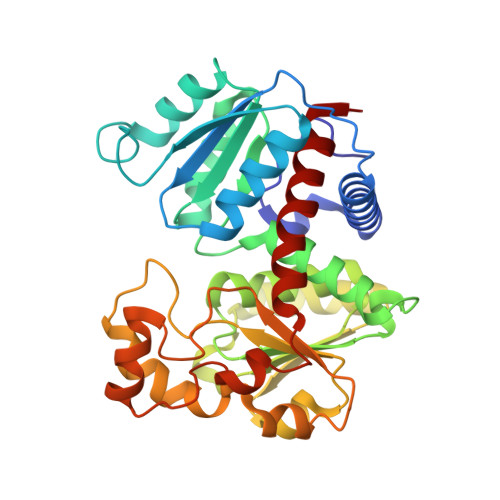Mechanism of inactivation of ornithine transcarbamoylase by Ndelta -(N'-Sulfodiaminophosphinyl)-L-ornithine, a true transition state analogue? Crystal structure and implications for catalytic mechanism.
Langley, D.B., Templeton, M.D., Fields, B.A., Mitchell, R.E., Collyer, C.A.(2000) J Biological Chem 275: 20012-20019
- PubMed: 10747936
- DOI: https://doi.org/10.1074/jbc.M000585200
- Primary Citation of Related Structures:
1DUV - PubMed Abstract:
The crystal structure is reported at 1.8 A resolution of Escherichia coli ornithine transcarbamoylase in complex with the active derivative of phaseolotoxin from Pseudomonas syringae pv. phaseolicola, N(delta)-(N'-sulfodiaminophosphinyl)-l-ornithine. Electron density reveals that the complex is not a covalent adduct as previously thought. Kinetic data confirm that N(delta)-(N'-sulfodiaminophosphinyl)-l-ornithine exhibits reversible inhibition with a half-life in the order of approximately 22 h and a dissociation constant of K(D) = 1.6 x 10(-12) m at 37 degrees C and pH 8.0. Observed hydrogen bonding about the chiral tetrahedral phosphorus of the inhibitor is consistent only with the presence of the R enantiomer. A strong interaction is also observed between Arg(57) Nepsilon and the P-N-S bridging nitrogen indicating that imino tautomers of N(delta)-(N'-sulfodiaminophosphinyl)-l-ornithine are present in the bound state. An imino tautomer of N(delta)-(N'-sulfodiaminophosphinyl)-l-ornithine is structurally analogous to the proposed reaction transition state. Hence, we propose that N(delta)-(N'-sulfodiaminophosphinyl)-l-ornithine, with its three unique N-P bonds, represents a true transition state analogue for ornithine transcarbamoylases, consistent with the tight binding kinetics observed.
- Department of Biochemistry, The University of Sydney, Sydney 2006, Australia and the Horticultural and Food Research Institute of New Zealand, Mt Albert Research Centre, Auckland 1003, New Zealand.
Organizational Affiliation:


















